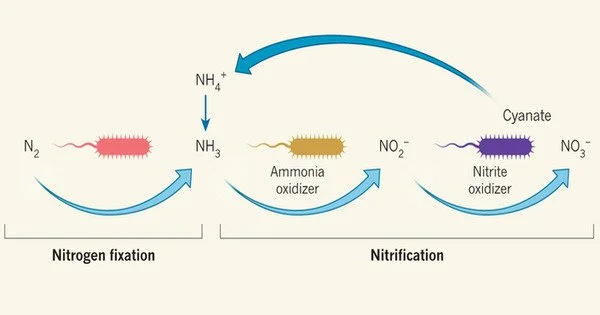Nitrifying bacteria are chemolithotrophic organisms from the genera Nitrosomonas, Nitrosococcus, Nitrobacter, Nitrospina, Nitrospira, and Nitrococcus. These are microorganisms that play an important part in the nitrogen cycle by converting various nitrogen molecules found in soil into plant-usable forms. These bacteria obtain their energy by the oxidation of inorganic nitrogen molecules. There are two types: ammonia-oxidizing bacteria (AOB) and nitrite-oxidizing bacteria (NOB). Nitrogen fixation, nitrification, ammonification, and denitrification are among the key processes in the nitrogen cycle.
Many nitrifying bacteria species have complex internal membrane systems that house key nitrification enzymes such as ammonia monooxygenase (which oxidizes ammonia to hydroxylamine), hydroxylamine oxidoreductase (which oxidizes hydroxylamine to nitric oxide, which is then oxidized to nitrite by an unidentified enzyme), and nitrite oxidoreductase.
Ecology
Nitrifying bacteria are classified into different taxonomic groupings and are most abundant where there is a lot of ammonia. Because of the high ammonia content, nitrifying bacteria thrive in lakes, streams, and rivers with heavy sewage, wastewater, and freshwater inputs and outputs.
Nitrifying bacteria are primarily involved in the nitrification process, which consists of two main steps:
Ammonium (NH4+) oxidation to Nitrite (NO2-): This step is carried out by bacteria known as ammonia-oxidizing bacteria (AOB). The most common genus of AOB is Nitrosomonas.
Nitrite (NO2-) oxidation to Nitrate (NO3-): This step is performed by another group of bacteria called nitrite-oxidizing bacteria (NOB). Nitrobacter is an example of a genus within this group.
The overall nitrification process can be represented by the following equations:
NH4+ →NO2– →NO3–
In the first step, ammonia (NH4+) is oxidized to nitrite (NO2-) by AOB, and in the second step, nitrite is further oxidized to nitrate (NO3-) by NOB. Both nitrite and nitrate forms of nitrogen are essential nutrients for plants, and they can be taken up by plant roots for growth and development.
















